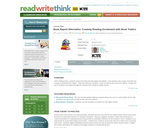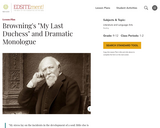
Worksheets and lessons on adverbs and adjectives for various reading levels.
- Subject:
- English Language Arts
- Material Type:
- Lesson Plan
- Provider:
- E Reading Worksheets
- Author:
- E Reading Worksheets
- Date Added:
- 02/26/2019

Worksheets and lessons on adverbs and adjectives for various reading levels.

Allegories are similar to metaphors: in both the author uses one subject to represent another, seemingly unrelated, subject. However, unlike metaphors, which are generally short and contained within a few lines, an allegory extends its representation over the course of an entire story, novel, or poem. This lesson plan will introduce students to the concept of allegory by using George Orwell’s widely read novella, Animal Farm, which is available on Project Gutenberg.

After reading books, students share book talks through digital storytelling. First, students plan scripts and then find images to illustrate their scripts. They also add text, narration, music as well as pan and zoom effects. Finally, the joy of reading is prompted through the sharing of the students' digital stories.

In this set of lessons, students read excerpts from "The Death of Benny Paret" by Norman Mailer and "The Fight" by William Hazlitt. Students annotate the text, specifically looking for metaphor and simile, tone, and syntax. Working with a partner, students write three paragraphs, analyzing metaphor or simile, tone, and syntax in "The Death of Benny Paret." Working independently, students write one paragraph, choosing to analyze metaphor or simile, tone, or syntax in "The Fight."

Reading Robert Browning's poem "My Last Duchess," students will explore the use of dramatic monologue as a poetic form, where the speaker often reveals far more than intended.

After students examine primary photographs, maps, and other documents that depict Chicago at the turn of the century, they will anticipate Sandburg's description of and attitudes towards the city. After reading a short biography of the poet they will make further predictions about the poem, and identify ways Sandburg uses literary techniques to make vivid the Chicago he knew. The lesson concludes with a piece of writing in which students describe a favorite place.

In "Paradox and Dream," a 1966 essay on the American Dream, John Steinbeck writes, "For Americans too the wide and general dream has a name. It is called "the American Way of Life.' No one can define it or point to any one person or group who lives it, but it is very real nevertheless." Yet a recent cover of Time Magazine reads "The History of the American Dream " Is It Real?" Here, students explore the meaning of the American Dream by conducting interviews, sharing and assessing data, and writing papers based on their research to draw their own conclusions.

This lesson helps students understand the complexities of The Wife of Bath's character and the rhetoric of her argument by exploring the various ways in which Chaucer crafts a persona for her. After familiarizing themselves with the framing narrative of the Canterbury Tales and its language, students study the Wife of Bath as a character. Finally, students examine several primary source documents written about women and marraige in order to understand the context in which the Wife presents her argument.

Worksheets and lessons on the correct use of prepositions for various reading levels.

In the TED Ed lesson focused on grammar, students will explore the age-old argument between linguistic prescriptivists and descriptivists — who have two very different opinions on the matter. Discussion questions and additional resources are linked in the sidebar.

As a way to support teachers with English Language Arts (ELA) instruction during the pandemic, the NCDPI ELA team created choice boards featuring standards-aligned ELA activities.The intended purpose of these choice boards is to provide a way for students to continue standards-based learning while schools are closed. Each activity can be adapted and modified to be completed with or without the use of digital tools. Many activities can also be repeated with different texts. These standards-based activities are meant to be a low-stress approach to reinforcing and enriching the skills learned during the 2019-2020 school year. The choice boards are to be used flexibly by teachers, parents, and students in order to meet the unique needs of each learner.Exploration activities are provided for a more self-directed or guided approach to independent learning for students. These activities and sites should be used as a way to explore concepts, topics, skills, and social and emotional competencies that interest the learner.

Students will learn how the field of war correspondence has evolved. Through reading chapters of Edith Warton's book, "Fighting France From Dunkerque to Belfort," students will cite examples of wartime reporting. FInally, students will create and present their own correspondence report.

In this lesson, students will edit their papers for grammar, focusing on hyphenation conventions, spelling, punctuation, and capitalization.

This essay prompt can serve as a culmination of the study of Their Eyes Were Watching God. A thorough study of the text allows students to follow several motifs throughout the text like roads, fences and gates, horizons, and the stages of trees. This lesson was developed by NCDPI as part of the Academically and/or Intellectually Gifted Instructional Resources Project. This lesson plan has been vetted at the state level for standards alignment, AIG focus, and content accuracy.

Known as both a Southern and a Catholic writer, Flannery O'Connor wrote stories that explore the complexities of these two identities. In this lesson, students will challengethese dichotomieswhile closely reading and analyzing "A Good Man is Hard to Find."

In this fourth unit of eight total, Think Alouds (pages 27-33 of the pdf), students will apply skills to investigate and understand text.

This lesson seeks to sensitize students to the complex nature of revenge as it is portrayed in Shakespeare's "Hamlet." Students learn how the play interprets Elizabethan attitudes towards revenge as reflected in the structure of the Elizabethan revenge tragedy. Students will analyze the use of language and actions to motivate the avengers in the play; recognize Elizabethan theatrical conventions and their impact; and compare the text with a modern film interpretation.

Worksheets and lessons on the correct use of interjections for various reading levels.

In this three-part lesson on the inner chapters of "The Grapes of Wrath" students will first determine the function of Steinbeck's opening chapter then explore the relationship between the inner chapters and the Joad narrative chapters throughout the novel. Students will view two documentaries along the way as well as read two relevant articles in order to draw their own conclusions about the purpose of this novel's inner chapters.

Students discuss and examine the differences between electronic communication such as texts and emails versus more "traditional" means of writing. There is also a discussion on audience and puropse when writing, and students will practice writing a "style guide" page in order to reinforce conventions of standard English.